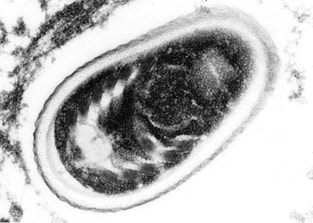|
Commonly referred to as E.cuniculi. As you may have seen from my Facebook page and my blog, my house rabbit Benji developed head tilt just over two weeks ago. (looking on the bright side) The most common cause of head tilt in rabbits is caused by the parasitic infection of E.cuniculi. I have come across E.cuniculi in rabbits before but never in my own rabbits so rather than just talk about Benji’s 28-day treatment plan, I decide to do some further research into this disease and share it with you. whilst we refer to a rabbit as having ‘head tilt’ or E.cuniculi the disease that the parasite causes is called encephalitozoonosis – you can see why we just call it head tilt! The infection affects the spinal cord, the brain and the kidneys.  A quick side note here; the information I have gathered has come from papers and studies written by vets, for vets and students. I’ll put some links to those below if you want to have a read. E.cuniculi is a parasitic protozoa. A protozoa is a single celled, microscopic organism. They multiply within their host which causes serious and sometimes life-threatening infections. So how is it spread? The general consensus from the information that I have read agrees that rabbits become infected from ingesting the parasite spores that have been shed in the urine of infected rabbits, including wild rabbits and rodents. Although less common, infection can also occur from inhalation of the spores and from mother to young during pregnancy.  Can humans get this disease? Well… If you have ever heard of zoonotic diseases you may have noticed the zoonosis part of encephalitozoonosis!! So, the answer is yes! But please don’t panic, the only people who are really at risk are those who are extremely immunocompromised. what are the signs? Before doing research for this blog, I thought that the first sign of head tilt was, well head tilt! However, I have since found out that hind leg weakness is a common sign, which Benji does have, something that we had put down to Benji’s age but took him to see a vet anyway and our vet thought was linked to his irregular heart rhythm. If it becomes advanced a rabbit can become paralyzed or roll around uncontrollably, which I can tell you from personal experience working with adoption rabbits, is horrible to see and must be awful for the rabbit. This symptom is thought to be caused by swelling around the parasite in the spinal cord causing damage to the nervous tissue. This damage can not be repaired. There are a few other symptoms and a rabbit may show some or all of them including:
Strangely one study showed that around 52% of healthy rabbits carry the parasite but may never suffer symptoms. It’s still not really understood why some rabbits get symptoms and other don’t. A much smaller percentage, around 6% develop signs of infection and when sever clinical signs develop it is recommended that that the rabbit be put to sleep. What can you do? Whilst there is a test for E.cuniculi it’s not really very useful as I said more than 50% of rabbits seem to have the parasite. The best advice I can find is to quarantine new rabbits from existing ones. Be sure to thoroughly disinfect when using a used hutch. These spores are pretty resistant to environmental changes so a good 1-10% bleach solution is a good idea.  If you just got a rabbit, no matter where it came from, it would be advisable to give it Lapizole (Panacure) for 28 days. You don’t need to get this from the vet, pet shops that sell licenced medication should stock it but there’s no harm in a vet check with a new pet. I know it sounds like a lot but if the rabbit does have the parasite it can kill it off before any symptoms and irreversible damage is done. Not only will I be treating Benji until February, I will also treat my four other rabbits this year. I can tell you now, some will be more trouble than others, there will be blood – Mine! Even if your rabbit doesn’t have any of the parasite there should be no adverse effects from giving Panacure. It would also be wise to wash any greens that have been gathered to feed your rabbits that may have come into contact with wild rabbits, I will keep you updated on my Panacure progress.
Useful links:
0 Comments
Leave a Reply. |
AuthorRebecca, owner and founder of R and R Pet services. Archives
May 2022
Categories |
Thank you for visiting!
Copyright © 2016
 RSS Feed
RSS Feed